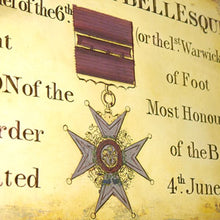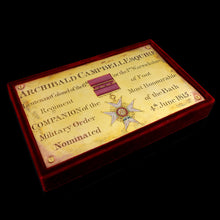6th (Warwickshire) Regiment of Foot - An Order of the Bath Chapel Stall Plate, 1815
Adding product to your cart
Overall: 20.5cm (8.1in) x 13cm (5.1in) x 3cm (1.2in)
Polychromed and gilded brass. The Most Honourable Order of the Bath, C.B. (Military) Companion’s, Chapel Stall Plate, with engraved and painted image of a C.B. badge, inscribed ‘Archibald Campbell Esquire / Lieutenant-Colonel of the 6th / (or the 1st Warwickshire) / Regiment / of Foot / Companion of the Most Honourable / Military Order of the Bath / Nominated 4th June 1815.’, 19.1cm x 11.5cm. Mounted on a modern velvet clad block.
The present stall plate was made for display in the chapel of The Most Honourable Order of the Bath - a military order established by Letters Patent of George I in 1725, when the Dean of Westminster was made Dean of the Order in perpetuity and King Henry VII's Chapel designated as the Chapel of the Order. The Order was a revival of an older custom going back to medieval times when part of the ceremony of knighthood included a ritual bath symbolic of spiritual purification and a vigil the night before receiving the honour. The Order was enlarged in 1815 and three classes of knights were formed: Knights Grand Cross, Knights Commander and Companions. A small number of distinguished civilians were also admitted at this time and in 1847 a civil division of Knights Commander and Companions was added.
Read more
Major-General Archibald Campbell, CB (1774-1838) was the son of Sir James Campbell of Inverneill, MP, Heritable Usher of the White Rod for Scotland and Chief of the Clan Chearlach. Archibald is recorded as taking part in the invasion of the Dutch colony at the Cape of Good Hope in 1795; in the Anglo-Mahratta War of 1803-1805, (possibly in the regiment raised in Glasgow by his kinsman Sir Archibald Campbell, KB, for service in India), and at the Capture of Martinique in early 1809. He is further recorded on the strength of the Royal West Indies Rangers later the same year. He transferred to the 4th Ceylon Regiment on 8 March 1810, and, following promotion to brevet Lieutenant-Colonel on 8 June 1810, he exchanged into the 6th (Warwickshire) Regiment Foot on 17 September 1812. He joined Wellington’s army in Spain in September 1812 and commanded the 1st Battalion 6th Foot at the Battle of Vittoria in June 1813.

He was later present at the Battle of the Pyrenees and in 1814 went with the 14th Foot to Canada In later life he was appointed Lieutenant Governor of Jersey in 1835 and died in office in 1838. He is buried in the Parish Church of St Helier.








